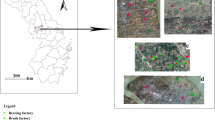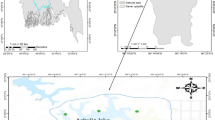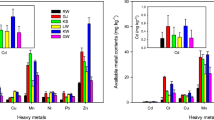Abstract
Metal contamination in farmlands irrigated with biogas slurry is of great concern because of its potential health risks to local inhabitants. Health risks that depend heavily on multi-pathway exposure to heavy metals (e.g., Pb, Cd, Cr, Zn, Cu, and As) in water, soil, air, and local food were studied through field sampling in Taihu Basin, China. Results show that Zn, Pb, and Cd in soils irrigated with biogas slurry exceed the soil quality standard values, and grown vegetables and grains contaminated with Pb and Cd exceed the permissible limits. Food ingestion plays an important role in the total average daily dose of metals, especially for Cu and Zn, which account for 94 and 91 %, respectively. Non-carcinogenic risks posed to adults mainly result from Cu, Zn, Pb, Cd, and As through food ingestion and from Cr through soil ingestion. The highest non-carcinogenic risk was determined from food ingestion, followed by soil ingestion, air inhalation, air ingestion, and dermal contact with air. Carcinogenic risks to adults are 6.68 to 7.00 times higher than the safe level and can be attributed to Cr, As, and Cd pollution. The estimated risks mainly result from As and Cd through food ingestion and from Cr through soil ingestion. Both cancer and non-cancer risks through dermal contact can be ignored. Therefore, attention should be paid to health risks imposed by adults’ multi-pathway exposure to heavy metals in vegetables, grains, and related soils irrigated with biogas slurry in Taihu Basin. Effective measures should be implemented to control heavy metal pollution and protect potentially exposed adults.





Similar content being viewed by others
References
Al-Saleh I, Nester M, Devol E, Shinwari N, Al-Shahria S (1999) Determinants of blood lead levels in Saudi Arabian schoolgirls. Int J Occup Environ Health 5:107–114
Baastrup R, Sorensen M, Balstrom T, Frederiksen K, Larsen CL, Tjonneland A et al (2008) Arsenic in drinking-water and risk for cancer in Denmark. Environ Health Perspect 116:231–237
Bolan NS, Khan MA, Donaldson DC, Matthew C (2003) Distribution and bioavailability of copper in farm effluent. Sci Total Environ 309:225–236
Cai LM, Xu ZC, Ren MZ, Guo QW, Hu XB, Hu GC, Wan HF, Peng PG (2012) Source identification of eight hazardous heavy metals in agricultural soils of Huizhou, Guangdong Province, China. Ecotox Environ Safe 78:2–8
Chen JM, Tan MG, Li YL, Zheng J, Zhang YM, Shan Z, Zhang GL, Li Y (2008) Characteristics of trace elements and lead isotope ratios in PM2.5 from four sites in Shanghai. J Hazard Mater 156:36–43
Chien LC, Hung TC, Choang KY, Yeh CY, Meng PJ, Shieh MJ, Han BC (2002) Daily intake of TBT, Cu, Zn, Cd and As for fishermen in Taiwan. Sci Total Environ 285:177–185
CNEMC (China National Environmental Monitoring Center) (1990) The background values of elements in Chinese soils. Environmental Science Press of China, Beijing (in Chinese)
Cui YJ, Zhu YG, Zhai RH, Chen DY, Huang ZH, Qiu Y, Liang JZ (2004) Transfer of metals from soil to vegetables in an area near a smelter in Nanning, China. Environ Int 30:785–791
Diaz RV, Dominguez ER (2009) Health risk by inhalation of PM(2.5) in the metropolitan zone of the City of Mexico. Ecotoxicology and Environmental Safety 72:866–871
Diaz-Somoano M, Kylander ME, López-Antón MA, Suarez-Ruiz I, Martínez-Tarazona MR, Ferrat M et al (2009) Stable lead isotope compositions in selected coals from around the world and implications for present day aerosol source tracing. Environ Sci Technol 43:1078–1085
Duruibe JO, Ogwuegbu MDC, Egwurugwu JN (2007) Heavy metal pollution and human biotoxic effects. Int J Phys Sci 2:112–118
Fang GC, Huang YL, Huang JH (2010) Study of atmospheric metallic elements pollution in Asia during 2000–2007. Journal of Hazardous Materials 180:115–121
General Administration of Quality Supervision, Inspection and Quarantine of China (2001)Safety Qualification for Agricultural Product-safety Requirements for Non-environmental Pollution Vegetable (GB18406.1-2001) (in Chinese)
Gržtić I (2008) Potential health risk assessment for soil heavy metal contamination in the central zone of Belgrade (Serbia). J Serb Chem Soc 73:923–34
Hu H, Yang Q, Lu X, Wang WC, Wang SS, Fan MH (2010) Air pollution and control in different areas of China. Critical Reviews in Environmental Science and Technology 40:452–518
Hu X, Zhang Y, Ding ZH, Wang TJ, Lian HZ, Sun YY, Wu JC (2012) Bioaccessibility and health risk of arsenic and heavy metals (Cd, Co, Cr, Cu, Ni, Pb, Zn and Mn) in TSP and PM2.5 in Nanjing, China. Atmospheric Environment 57:146–152
Huang ML, Zhou SL, Sun B, Zhao QG (2008) Heavy metals in wheat grain: assessment of potential health risk for inhabitants in Kunshan, China. Sci Total Environ 405:54–61
Institute of Medicine, Food and Nutrition Board (2004) Dietary Reference Intake (DRIs): recommended intakes for individuals, elements. National Academy Press, Washington, DC
Jang CS, Liu CW, Lin KH, Wang SW (2006) Spatial analysis of potential carcinogenic risks associated with ingesting arsenic in aquacultural tilapia (Oreochromis mossambicus) in blackfoot disease hyperendemic areas. Environ Sci Technol 40:1707–1713
Jarup L (2003) Hazards of heavy metal contamination. Brit Med Bull 68:167–182
Kabata-Pendias A, Mukherjee AB (2007) Trace elements from soil to human. Springer, NewYork
Kachenko AG, Singh B (2006) Heavy metals contamination in vegetables grown in urban and metal smelter contaminated sites in Australia. Water Air Soil Pollut 169:101–123
Lacatusu R, Rauta C, Carstea S, Ghelase I (1996) Soil–plant–man relationships in heavy metal polluted are as in Romania. Appl Geochem 11:105–107
Lai HY, Hseu ZY, Chen TC, Chen BC, Guo HY, Chen ZS (2010) Health risk-based assessment and management of heavy metals-contaminated soil sites in Taiwan. Int J Environ Res Publ Health 7:3595–3614
Lee H, Cho Y, Parka S, Kye S, Kim B, Hahm T et al (2006) Dietary exposure of the Korean population to arsenic, cadmium, lead and mercury. J Food Compos Anal 19:31–37
Li F, Ni L, Yuan J, Daniel Sheng G (2010) Cultivation practices affect heavy metal migration between soil and Vicia faba (broad bean). Chemosphere 80:1393–1398
Liu HY, Probst A, Liao BH (2005) Metal contamination of soils and crops affected by the Chenzhou lead/zinc mine spill (Hunan, China). Sci Total Environ 339:153–166
Lopes C, Herva M, Franco-Uría A, Roca E (2011) Inventory of heavy metal content in organic waste applied as fertilizer in agriculture: evaluating the risk of transfer into the food chain. Environ Sci Pollut Res 18:918–939
Lopes C, Herva M, Franco-Uría A, Roca E (2012) Multicorrelation models and uptake factors to estimate extractable metal concentrations from soil and metal in plants in pasturelands fertilized with manure. Environ Pollut 166:17–22
Man YB, Sun XL, Zhao YG, Lopez BN, Chung SS, Wu SC et al (2010) Health risk assessment of abandoned agricultural soils based on heavy metal contents in Hong Kong, the world’s most populated city. Environ Int 36:570–6
Mari M, Nadal M, Schuhmacher M, Domingo JL (2009) Exposure to heavy metals and PCDD/Fs by the population living in the vicinity of a hazardous waste landfill in Catalonia, Spain: health risk assessment. Environ Int 35:1034–1039
MEP (2008) Environmental quality standards for soils. Ministry of Environmental Protection, China.GB15618-2008
Meza-Figueroa D, De la O-Villanueva M, De la Parra ML (2007) Heavy metal distribution in dust from elementary schools in Hermosillo, Sonora, México. Atmos Environ 41:276–288
MHP (2006) Standards for drinking water quality. The Ministry of Health of P.R., China. GB5749-2006
Ministry of Environmental Protection the People’s Republic of China (2014) Technical guidelines for risk assessment of contaminated sites. pp 25–38
Ministry of Health, PRC (1991) Tolerance limit of zinc (GB13106-91) in foods. Standards Press of China, Beijing (in Chinese)
Ministry of Health, PRC (1994) Tolerance limit of copper (GB15199-94) in foods. Standards Press of China, Beijing (in Chinese)
Muchuweti M, Birkett JW, Chinyanga E, Zvauya R, Scrimshaw MD, Lister JN (2006) Heavy metal content of vegetables irrigated with mixtures of wastewater and sewage sludge in Zimbabwe: implication for human health. Agr Ecosys Environ 112:41–48
Nadal M, Bocio A, Schuhmacher M, Domingo JL (2005) Trends in the levels of metals in soils and vegetation samples collected near a hazardous waste incinerator. Arch Environ Contam Toxicol 49:290–298
NRC (National Research Council) (1993). Issues on risk assessment. Committee on risk assessment methodology. National Research Council, National Academy Press, Washington, D.C
Oliver MA (1997) Soil and human health: a review. Eur J Soil Sci 48:573–592
Pruvot C, Douay F, Herve F, Waterlot C (2006) Heavy metals in soil, crops and grass as a source of human exposure in the former mining areas. J Soils Sediments 6:215–220
Raghunath R, Tripathi RM, Kumar AV, Sathe AP, Khandekar RN, Nambi KSV (1999) Assessment of Pb, Cd, Cu, and Zn exposures of 6- to 10-year-old children in Mumbai. Environ Res 80:215–221
Reeves PG, Chaney RL (2001) Mineral nutrients status of female rats affects the absorption and organ distribution of cadmium from sunflower kernels (Helianthus annuus L.). Environ Res 85:215–225
Río M, Franco-Uría A, Abad E, Roca E (2011) A risk-based decision tool for the management of organic waste in agriculture and farming activities (FARMERS). J Hazard Mater 185:792–800
Santos EE, Lauria DC, Silveira PCL (2004) Assessment of daily intake of trace elements due to consumption of foodstuffs by adult inhabitants of Rio de Janeiro City. Sci Total Environ 327:69–79
Sekomo CB, Nkurang E, Rousseau DP, Lens PN (2011) Fate of heavy metals in an urban natural wetland: the Nyabugogo Swamp (Rwanda). Water Air Soil Pollut 214:321–333
Shah MT, Ara J, Muhammad S, Khan S, Tariq S (2012) Health risk assessment via surface water and sub-surface water consumption in the mafic and ultramafic terrain, Mohmand agency, northern Pakistan. J Geochem Explor 118:60–67
Tripathi RM, Raghunath R, Krishnamoorthy TM (1997) Dietary intake of heavy metals in Bombay city. India Sci Total Environ 208:149–159
US EPA (United States Environmental Protection Agency) (2000) Handbook for non-cancer health effects evaluation. US Environmental Protection Agency, Washington (DC)
US EPA (2001) Risk assessment guidance for superfund: volume III—part A, process for conducting probabilistic risk assessment. US environmental protection agency, Washington, DC [EPA 540-R-02-002]
US EPA (2004) Risk assessment guidance for superfund. Volume I: human health evaluation manual-part E, supplemental guidance for dermal risk assessment. Office of superfund remediation and technology innovation, Washington, DC [EPA/540/R/99/005.OSWER 9285. 7-02EP PB99-963312]
US EPA (2011) Exposure factors handbook 2011 edition (Final). http://cfpub.epa.gov/ncea/risk/recordisplay.cfm?deid=236252
Wang SQ, Zhou DM, Wang YJ, Chen HM (2003) Effect of o-phenylenediamine on Cu adsorption and desorption in red soil and its uptake by paddy rice (Oryza sativa). Chemosphere 51:77–83
Wang X, Sato T, Xing B, Tao S (2005) Health risk of heavy metals to the general public in Tianjin, China via consumption of vegetables and fish. Sci Total Environ 350:28–37
Wang G, Su M, Chen Y (2006) Transfer characteristics of cadmium and lead from soil to the edible parts of six vegetable species in southeastern China. Environ Pollut 144:127–135
WHO (World Health Organization) (1993) Evaluation of certain food additives and contaminants. 41st Report of the Joint FAO/WHO epert Committee on Food Additives. Technical Report Series. WHO, Geneva
Yang Y, Zhang FS, Li HF, Jiang RF (2009) Accumulation of cadmium in the edible parts of six vegetable species grown in Cd-contaminated soils. Journal of Environmental Management 90(2):1117–1122
Yang Y, Xie QQ, Yu YJ, Li DL, Lu XS (2012) Study on exposure parameters in Taihu lake basin dermal exposure parameters. J Environ Health 29:1091–1095 (in Chinese)
Yang Y, Yu YJ, Yang J, Xie QY, Li DL (2013) Exposure parameters of human activity pattern in Taihu Lake basin. J Environ Health 30:230–234 (in Chinese)
Zheng N, Wang QC, Zhang XW, Zheng DM, Zhang ZS, Zhang SQ (2007) Population health risk due to dietary intake of heavy metals in the industrial area of Huludao city, China. Sci Total Environ 387:96–104
Zhou DM, Hao XZ, Wang YJ, Dong YH, Cang L (2005) Copper and Zn uptake by radish and pakchoi as affected by application of livestock and poultry manures. Chemosphere 59:167–175
Zhuang P, Murray BM, Xia HP, Li NY, Li Z (2009) Health risk from heavy metals via consumption of food crops in the vicinity of Dabaoshan mine, South China. Sci Total Environ 407:1551–1561
Acknowledgments
Financial support for this study was provided by Jiangsu province Environmental Protection Key Project (No.2013010) and the Program for “333” Excellent Talents in Jiangsu Province (BRA2014375), the National Water Pollution Control and Management Technology Major Projects (Grant No. 2012ZX07506-008).
Conflict of interest
The authors declare that there are no conflicts of interest.
Author information
Authors and Affiliations
Corresponding author
Additional information
Responsible editor: Céline Guéguen
Rights and permissions
About this article
Cite this article
Bian, B., Zhou, L.J., Li, L. et al. Risk assessment of heavy metals in air, water, vegetables, grains, and related soils irrigated with biogas slurry in Taihu Basin, China. Environ Sci Pollut Res 22, 7794–7807 (2015). https://doi.org/10.1007/s11356-015-4292-2
Received:
Accepted:
Published:
Issue Date:
DOI: https://doi.org/10.1007/s11356-015-4292-2




